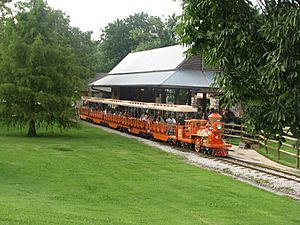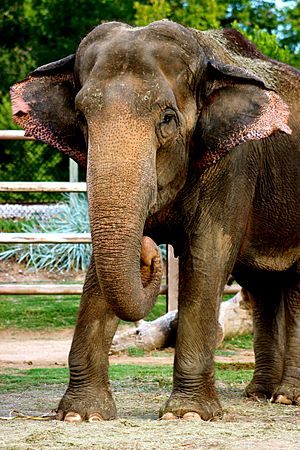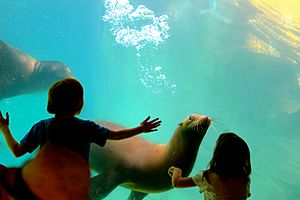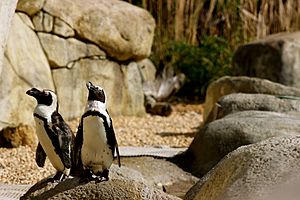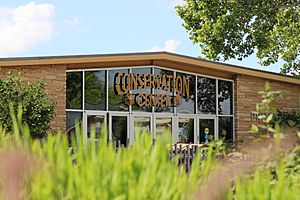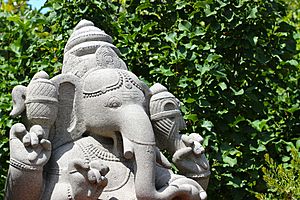Tulsa Zoo facts for kids
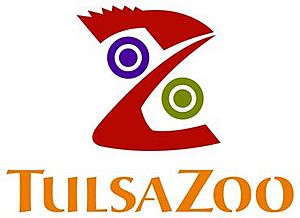 |
|
| Date opened | 1927 |
|---|---|
| Location | Mohawk Park, Tulsa, Oklahoma, United States |
| Land area | 85 acres (34 ha) |
| Coordinates | 36°12′31″N 95°55′47″W / 36.20868°N 95.92978°W |
| No. of animals | 1,500 |
| No. of species | 436 |
| Annual visitors | 600,000 |
| Memberships | AZA, AAM |
The Tulsa Zoo is a big zoo in Tulsa, Oklahoma, covering about 84 acres. It's owned by the City of Tulsa but has been managed by a private group, Tulsa Zoo Management, Inc., since 2010. The zoo is part of Mohawk Park, which is one of the biggest city parks in the United States. The zoo operates as a non-profit, meaning it uses its money to help the animals and educate visitors.
The zoo has many cool exhibits, like the Lost Kingdom and its special Valley of the Elephant area. The Tulsa Zoo is a top-notch zoo, officially recognized by the Association of Zoos and Aquariums (AZA). This means it meets high standards for animal care and conservation.
Contents
- Animals and Amazing Exhibits
- Lost Kingdom: Explore Ancient Asia
- Robert J. LaFortune Wild Life Trek: Animals from Around the World
- The Rainforest: A Tropical Adventure
- Chimpanzee Connection: Playful Primates
- Helmerich Sea Lion Cove: Underwater Fun
- Penguin Habitat: Waddle and Splash
- African Plains: Safari Adventure
- Children's Zoo: Meet Farm Friends
- Dave Zucconi Conservation Center: Diverse Creatures
- Tulsa Penguins On Parade: Art for Animals
- Conservation Efforts: Helping Animals Worldwide
- Tulsa Zoo History Highlights
Animals and Amazing Exhibits
The Tulsa Zoo is home to over 1,500 animals from 436 different species! Let's explore some of the exciting places you can visit.
Lost Kingdom: Explore Ancient Asia
The Lost Kingdom exhibit takes you on a journey to ancient Asian cultures. Imagine walking through beautiful gardens inspired by places like Angkor-Wat. Here, you can see amazing animals such as Malayan tigers, snow leopards, Chinese alligators, siamangs (a type of gibbon), binturongs (also known as bearcats), and giant Komodo dragons.
Valley of the Elephant: Gentle Giants
The Valley of the Elephant is a huge area, about 2.5 acres, designed just for the zoo's elephants. You can watch these gentle giants from both indoor and outdoor viewing spots. The exhibit even has a special yard where you can see elephant demonstrations. The zoo currently has five Asian elephants: two males named Sneezy and Hank, and three females named Sooky, Booper, and Connie. A new Asian Elephant habitat opened in 2024, giving these amazing animals even more space to roam.
Robert J. LaFortune Wild Life Trek: Animals from Around the World
The Robert J. LaFortune Wild Life Trek is a large complex with four buildings. It used to be called the North American Living Museum, but now it features animals from all over the world! This exhibit teaches you how animals adapt to different environments like water, deserts, forests, and cold places. You might see graceful Siberian cranes, camouflaged tawny frogmouths, colorful emerald doves, fluffy chinchillas, unique peccarys, tiny seahorses, and powerful grizzly bears.
The Rainforest: A Tropical Adventure
Step into The Rainforest and feel like you're in the middle of Central and South America! This exhibit is filled with lush plants and amazing creatures. Look for black howler monkeys, a giant green anaconda, sharp-toothed piranhas, small dwarf caimans, majestic jaguars, and bright golden-headed lion tamarins. Many birds, two-toed sloths, and Jamaican fruit bats even fly or move freely above you! The roof lets in natural light, making it feel like a real rainforest canopy.
Chimpanzee Connection: Playful Primates
The Chimpanzee Connection is an outdoor home for the zoo's chimpanzees. It has a fun climbing structure with cargo nets and ropes, caves, and even a termite mound. You can watch the chimpanzees play and explore from inside the "Chimpanzee Connection" building through large glass windows. This exhibit was finished in 1991.
Helmerich Sea Lion Cove: Underwater Fun
The Helmerich Sea Lion Cove is where the playful California sea lions live. It opened in 2012 and features a big saltwater pool, a cool underwater viewing window, a waterfall, and rocky areas where the sea lions can rest. It's a great place to watch them swim and play!
Penguin Habitat: Waddle and Splash
The Zoo's Penguin Habitat opened in 2002. This area, called "Oceans and Islands," is home to African penguins, a colony of bright flamingos, and unique black and white ruffed lemurs. The penguin exhibit has a special wave pool and rocky coastline, just like their natural home.
African Plains: Safari Adventure
The African Plains area of the zoo lets you feel like you're on a safari! Here, you can see a variety of animals, including curious meerkats, tall giraffes, powerful lions, ancient aldabra tortoises, massive southern white rhinos, and clever African wild dogs. The zoo recently opened the Mary K. Chapman Rhinoceros Reserve, a new and improved home for its two white rhinos.
Children's Zoo: Meet Farm Friends
The Children's Zoo is a special place where you can get up close with some friendly animals. In the contact yard, you can interact with Nigerian dwarf goats, Southdown sheep, Katahdin sheep, earless American Lamancha goats, and Anglo-Nubian goats. You'll also find dexter cows, tiny miniature horses, and Guinea forest hogs. This area also has an Australian Outback section with hopping red kangaroos and playful North American river otters.
Dave Zucconi Conservation Center: Diverse Creatures
Built in 1957, the Conservation Center is home to a wide variety of animals, including primates, reptiles, birds, and fish. Some of the animals you can see here are bright American flamingos, unique wrinkled hornbills, giant giant snakehead fish, beautiful radiated tortoises, smart Diana monkeys, white-faced white-faced saki monkeys, colorful Fiji banded iguanas, and a rare Grand Cayman Island blue iguana.
Tulsa Penguins On Parade: Art for Animals
The African black-footed penguin exhibit was helped by a city-wide art project. Businesses and organizations that donated to the exhibit received 6-foot tall sculptures of penguins. These sculptures were decorated in unique ways based on their location or owner. There were originally 29 of these "Tulsa Penguins" around the city, making them a popular sight!
Conservation Efforts: Helping Animals Worldwide
The Tulsa Zoo is very involved in helping animals and their habitats around the world. Their Conservation Program has supported over 200 projects, both globally and right in Tulsa. This includes educational programs to help reduce the use of palm oil, supporting FrogWatch USA (a program that helps monitor frogs and toads), and teaching people about how to protect our oceans.
Tulsa Zoo History Highlights
The Tulsa Zoo has a long and interesting history! Here are some key moments:
- 1927: The Tulsa Zoological Society was officially started.
- 1931: "Monkey Island" opened, with 40 monkeys.
- 1950: "Duke," the first chimpanzee, arrived at the zoo.
- 1954: "Gunda," the zoo's first elephant, arrived. She was a four-year-old female Asian elephant.
- 1957: The Primate Aviary Building (now the Conservation Center) was completed.
- 1962: The first giraffes, a pair of reticulated giraffes, arrived at the zoo.
- 1964: New homes for cats, bears, sea lions, and flamingos were finished. The zoo's first polar bear also arrived.
- 1970: The Tulsa Zoo became one of the first zoos in the nation to use a computer system to keep track of its animals.
- 1972: "Wildlife on Wheels," an educational program, began. The zoo also started charging an admission fee.
- 1976: The zoo was officially named Tulsa Zoological Park and became one of the first zoos to be accredited by the AAZPA (now the AZA).
- 1977: The Children's Zooseum opened, and the African Savanna exhibit began construction. The zoo also hired its first full-time veterinarian.
- 1978: The Robert J. Lafortune North American Living Museum officially opened.
- 1982: The Tulsa Zoo received accreditation from the American Association of Museums. A new snow leopard exhibit was built.
- 1986: "Maverick," the first Asian elephant born in Oklahoma, was born at the zoo.
- 1988: Dr. Jane Goodall, a famous chimpanzee expert, visited the zoo and praised its chimpanzee exhibit.
- 1991: The indoor Chimpanzee Connection opened to the public.
- 1993: The new main entry, gift shop, and restaurant opened. Sadly, Maverick the Asian elephant passed away at age seven.
- 1997: The Helmerich Discovery Center was completed, and the Tropical American Rainforest exhibit opened.
- 1998: The Children's Zoo contact yard opened.
- 2002: The African Penguin exhibit officially opened.
- 2005: The Tulsa Zoo was named "America's Favorite Zoo" in a national competition by Microsoft.
- 2006: The Oklahoma Trails exhibit was added to celebrate Oklahoma's 100th birthday.
- 2012: Sea Lion Cove, a new home for sea lions, was completed.
- 2013: The Robert J. Lafortune North American Living Museum reopened as the Robert J. Lafortune WildLIFE Trek, featuring animals from around the world.
- 2014: The Mary K. Chapman Rhino Reserve opened.
- 2017: The Lost Kingdom exhibit opened.
- 2018: Gunda, the zoo's first elephant, passed away at 68 years old. She was one of the oldest elephants in captivity in the country.
- 2022: Construction began on the Oxley Family Elephant Experience and Elephant Preserve.
- 2024: The new Asian Elephant habitat opened.


